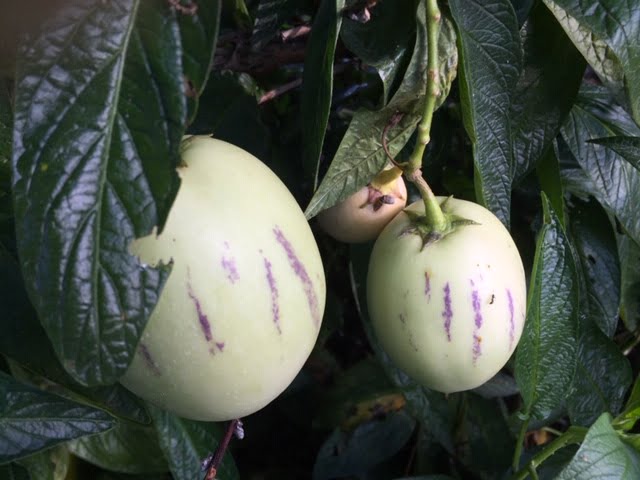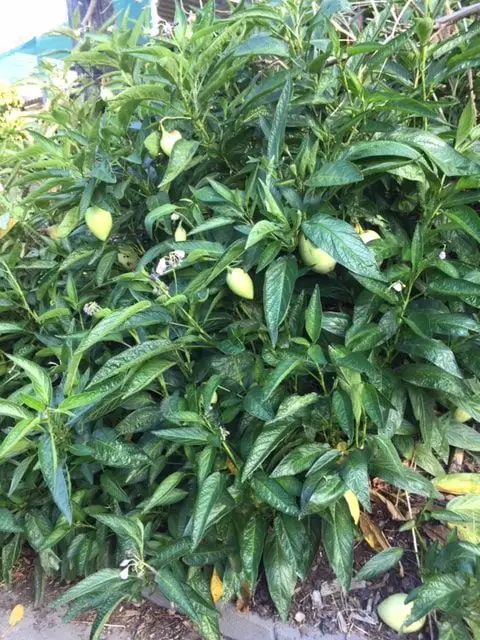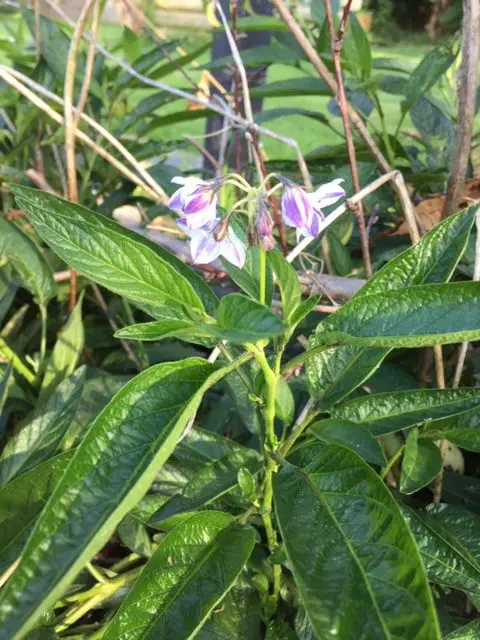How Much Does A Pepino Plant Produce? The Pepino plant is a member of the Solanaceae family and is native to South America. The plant produces a relative melon-like fruit that has a flavor that is somewhere between a cucumber and cantaloupe. It is a perennial plant that can serve as an alternative to fruit such as cantaloupe which needs to planted every year and is generally a less reliable producer of fruit. So how does the yield compare between a Pepino and a Cantaloupe?
A mature Pepino plant will typically produce between 15 and 25 fruit in a season. The fruit typically melons typically weigh between 9 and 14 oz (250 and 400g) which means a typical yield for a plant is around 13 lbs (6 kg) per annum. However, the study by the Kocaeli University indicates that a Pepino seedling planted in early spring will produce around 2 to 7 fruit in its first season or around 1 to 4 lbs (600g to 2.1 kg).
This yield compares favorably to Cantaloupe yields which are typically around 10 lbs (4.5 kg) per season according to a study by Purdue University, to see the results of the best cantaloupe varieties click here. The additional advantages of Pepino are;
- It is perennial, which means the seed does not need to be planted every year.
- It produces a larger number of smaller fruit, this is advantageous because it is difficult to eat a 4lb (2 kg) fruit in a single sitting and once cut the cantaloupe do not keep well. A cantaloupe plant will typically produce 2 to 3 fruit per plant.
- Pepino requires less maintenance than Cantaloupes and is generally more forgiving than with respect to soil conditions and soil moisture particularly once established.
- As a result of the Pepino’s hardiness, they are a more reliable cropper than Cantaloupes
- Pepinos are easy to propagate
- They are suitable for diabetics to eat due to their relatively low carbohydrate levels.

In What Conditions Can A Pepino Be Grown?
Pepino plants are suitable for growing in zone 9 or higher, however, they can be grown in cooler climates if the plants are protected from freezing conditions in the winter.
The plant will survive hard frosts but the leaves will be damaged extensively and will die back. It is typical to see young growth appear in spring only to be destroyed by a frost, the tell-tale sign of frost is the blackening of the leaves. In zone 10, where I live, it is not necessary to protect the plant against frost because it quickly recovers and it does not affect the yield significantly.
However, if you live in a cooler location that is prone to late frosts it is advisable to use a frost blanket to protect the plant. The frost blankets are designed to be breathable allowing light, air, and moisture through while protecting the tender leaves from the worst of the weather, to see the latest price on Amazon click here.
Do You Need More Than One Pepino Plant To Produce Fruit?
Pepino are a self-fertile plant, which means only one plant is required to produce fruit. However, it never hurts to have a second plant in your yard as this will sometimes increase the rate of pollination.
How To Grow Pepino
Pepino plant is a medium-sized deciduous shrub that has lush green foliage that is suitable for use in ornamental as well as productive gardens. A mature plant will typically reach a height and width of around 3 to 4 ft (1 to 1.2m). They are generally a really easy plant to grow and require relatively little maintenance.
As mentioned above Pepinos are suitable for growing zone 9 or higher but perform best in frost-free environments. If plants are grown in cooler environments it best to grow them in containers to allow the plant to be brought inside to protect it from freezing conditions.

When planting a Pepino it is best to plant them in Spring as the weather is warming up. The plants can usually be purchased as tube stock or more mature plants, we recommend that you purchase tube stock as it is cheaper and the plant grows relatively quickly so there isn’t a lot to be gained by spending more on a larger plant.
When selecting a location it is best to choose a warm sunny location that gets at least 6 to 8 of sun a day. The plant will tolerate shady positions but in these locations, the plant will not grow as large and the fruit will be few and far between.
In terms of soil conditions, Pepino are quite tolerant of a range of soil conditions, however, they will perform best in moist well-drained soil that has plenty of organic matter and is slightly acidic, a pH of 6.5 is ideal. To read more about why pH is important click here.
To check the soil pH a test kit may be used, however, I have generally found the pH meters are easier to use and also cheaper. To see the latest price on Amazon click here.
If the pH is outside the desired range it may be adjusted by adding lime to increase the pH or sulfur to reduce the pH. It is also advisable to add compost to the soil to improve the available nutrients. Any additions to the soil should be mixed into the soil thoroughly.
Once the soil is prepared dig a planting hole that is approximately twice the depth and width of the pot the plant came in. Then remove the plant from the pot and tease out the roots before placing it in the planting hole.
Position the plant at the same depth as the plant was originally in the pot and then backfill the hole with soil. Ensure that the soil is firmly packed around the root ball of the plant to avoid the presence of air pockets.
Once the plant is in position water the plant in well to ensure that the ground is thoroughly saturated. Place a thick layer of organic mulch around the base of the plant, 2 to 4 inches (5 to 10 cm) thick is ideal. When placing the mulch around the base of the plant ensure that it does not come in direct contact with the stem of the plant to avoid any risk of collar rot.
In the first season, it is important to ensure that the plant is kept moist as it is more susceptible to dry conditions as the root system is yet to fully develop. In the following seasons, the established root system will allow the plant to tolerate periods of dry much more readily. However, in periods of dry the plant will always benefit from being watered, as lack of moisture can result in underdeveloped fruit.

After the first season, the volume of ongoing maintenance is minimal. It is recommended that the plant be fed in early Spring and in Summer with pelletized manure. However, I have found that you can get away with not even doing that, as my plant fruits year in and out without fertilization.
Additionally, you don’t need to prune the plants as their size is limited, however, pruning does encourage the plant to become bushy. To maintain a neat plant a tip prune is recommended to reshape the plant as desired. In general, the plant is extremely forgiving and will recover quickly from any pruning no how dramatic.
When To Harvest Pepino
Pepinos generally will start to ripen from late summer to Autumn. The fruit initially starts out a pale green color and progresses to a pale yellow color which is a strong indicator that the fruit is ready to pick.
Additionally, the fruit will start to soften which is another indicator the fruit is ready to pick. To test this squeeze the fruit gently, if there is a little give in the flesh it is ready to harvest.
Fruits that are slightly green can also be taken inside and allowed to ripen indoors on a window ceil in a similar fashion to a tomato. Once ripe Pepinos will store for a few weeks in the refrigerator provided that the fruit has not been bruised or damaged in any way.
How To Propagate Pepino
If you want to increase the number of plants you have Pepino can be easily propagated from cuttings. Cuttings can be taken at any stage but the best time is in late winter or spring.
The cuttings taken from the plant should be 4 to 6 inches long, the lower end of the cutting should be taken just below a node. The cutting’s base should be trimmed at a 45-degree angle to expose the maximum surface area to the soil.
To increase your chances of cutting developing roots it is advisable to use rooting hormone. Root hormone can be purchased relatively cheaply on Amazon click here to see the latest price.
When placing the cutting in soil use a pencil to create the hole to avoid the rooting hormone from being dislodged by the soil as it pushed down into the soil. When planting cuttings it is best to place 4 or 5 cuttings around the edge of the pot because it will be slightly warmer than the center of the pot. At this stage, it is important to keep the pot moist by watering it regularly.
The cutting will take several weeks to develop a root system and begin to create new top growth. Once this occurs it is advisable to transplant the new plants into individual pots for an additional few weeks before planting them into the garden.
